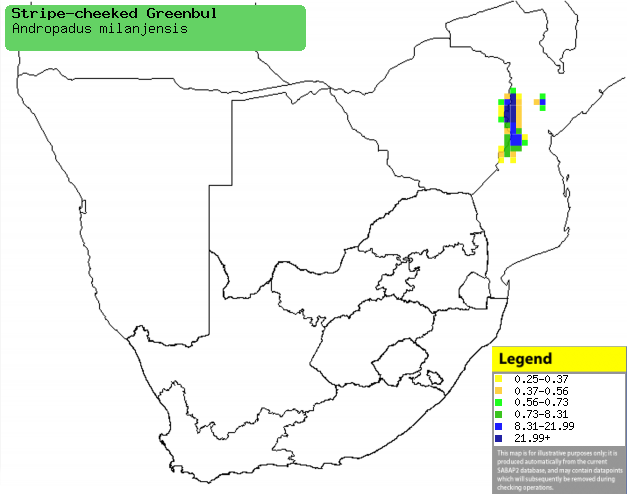|
Andropadus milanjensis
(Stripe-cheeked greenbul, Stripe-cheeked bulbul)
Streepwangwillie [Afrikaans]; Streepwang-buulbuul
[Dutch]; Bulbul montagnard [French]; Strichel-grünbülbül [German]; Tuta
do Milange [Portuguese]
Life
> Eukaryotes >
Opisthokonta
> Metazoa (animals) >
Bilateria >
Deuterostomia > Chordata >
Craniata > Vertebrata (vertebrates) > Gnathostomata (jawed
vertebrates) > Teleostomi (teleost fish) > Osteichthyes (bony fish) > Class:
Sarcopterygii (lobe-finned
fish) > Stegocephalia (terrestrial
vertebrates) > Tetrapoda
(four-legged vertebrates) > Reptiliomorpha > Amniota >
Reptilia (reptiles) >
Romeriida > Diapsida > Archosauromorpha > Archosauria >
Dinosauria
(dinosaurs) > Saurischia > Theropoda (bipedal predatory dinosaurs) >
Coelurosauria > Maniraptora > Aves
(birds) > Order: Passeriformes
> Family: Pycnonotidae
Distribution and habitat
Occurs in northern Mozambique, Malawi and southern Africa,
where it is locally common in Zimbabwe's eastern highlands and adjacent
Mozambique. It generally prefers moist montane forest, sometimes moving into
nearby scrub, wattle plantations and miombo (Brachystegia) woodland.
|
 |
|
Distribution of Stripe-cheeked greenbul in southern Africa,
based on statistical smoothing of the records from first SA Bird Atlas
Project (©
Animal Demography unit, University of
Cape Town; smoothing by Birgit Erni and Francesca Little). Colours range
from dark blue (most common) through to yellow (least common). |
Food
It eats fruit, seeds, insects and worms, creeping along
branches in the tree canopy, sometimes hawking prey aerially or plucking them
from the ground.
Breeding
- The nest is a small, flimsy cup built of roots, twigs and grass and
covered with cocoons, leaves, moss, shredded bark and lichen. It is
typically placed in the canopy of a bush, sapling or creeper about 2-7
metres above ground.
- Egg-laying season is from October-March, peaking from November-December.
- It lays 1-2, usually 2 eggs which are incubated solely by the female.
Threats
Not threatened.
References
-
Hockey PAR, Dean WRJ and Ryan PG 2005. Roberts
- Birds of southern Africa, VIIth ed. The Trustees of the John Voelcker
Bird Book Fund, Cape Town.
-
Harrison, J.A., Allan, D.G., Underhill, L.G., Herremans, M.,
Tree. A.J., Parker, V. & Brown, C.J. (eds). 1997. The atlas of southern
African birds. Vol. 2: Passerines. BirdLife South Africa, Johannesburg.
|
